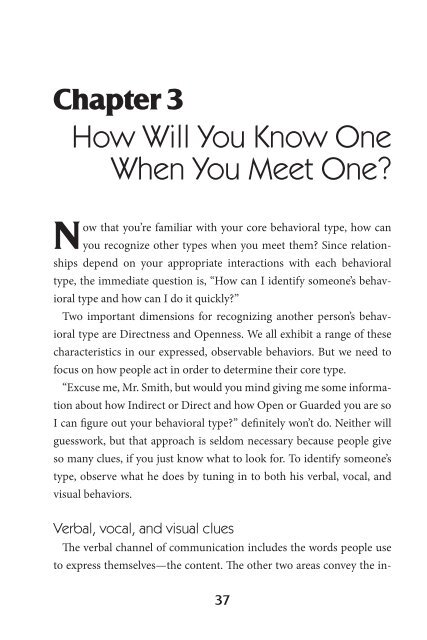PeopleSmart in Business eBook - The Platinum Rule
PeopleSmart in Business eBook - The Platinum Rule
PeopleSmart in Business eBook - The Platinum Rule
Create successful ePaper yourself
Turn your PDF publications into a flip-book with our unique Google optimized e-Paper software.
Chapter 3<br />
How Will You Know One<br />
When You Meet One?<br />
Now that you’re familiar with your core behavioral type, how can<br />
you recognize other types when you meet them? S<strong>in</strong>ce relationships<br />
depend on your appropriate <strong>in</strong>teractions with each behavioral<br />
type, the immediate question is, “How can I identify someone’s behavioral<br />
type and how can I do it quickly?”<br />
Two important dimensions for recogniz<strong>in</strong>g another person’s behavioral<br />
type are Directness and Openness. We all exhibit a range of these<br />
characteristics <strong>in</strong> our expressed, observable behaviors. But we need to<br />
focus on how people act <strong>in</strong> order to determ<strong>in</strong>e their core type.<br />
“Excuse me, Mr. Smith, but would you m<strong>in</strong>d giv<strong>in</strong>g me some <strong>in</strong>formation<br />
about how Indirect or Direct and how Open or Guarded you are so<br />
I can fi gure out your behavioral type?” defi nitely won’t do. Neither will<br />
guesswork, but that approach is seldom necessary because people give<br />
so many clues, if you just know what to look for. To identify someone’s<br />
type, observe what he does by tun<strong>in</strong>g <strong>in</strong> to both his verbal, vocal, and<br />
visual behaviors.<br />
Verbal, vocal, and visual clues<br />
Th e verbal channel of communication <strong>in</strong>cludes the words people use<br />
to express themselves—the content. Th e other two areas convey the <strong>in</strong>-<br />
37


